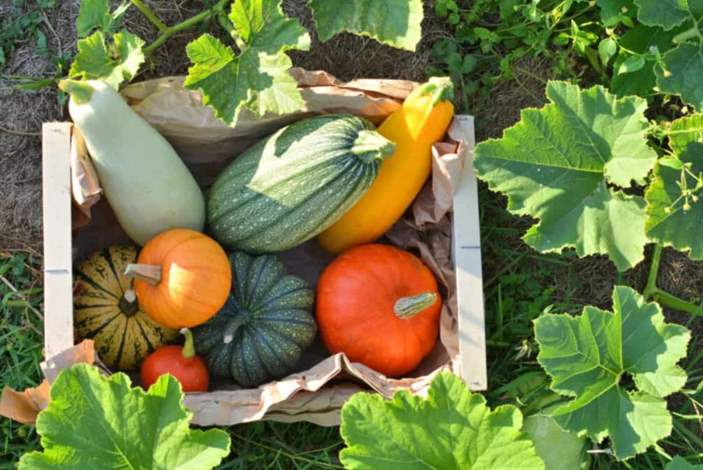Squashes are edible plants and fruits of various genus Cucurbita species in the family Cucurbitaceae (the guard family or cucurbits). They can be summer (immaturely harvested) or winter, harvested once they mature.
Before we go ahead and tell you if they are ok for bunnies, you deserve to know that not all plants in the genus Cucurbita are safe for your consumption or your rabbit. Some have bitter-tasting cucurbitacins responsible for Toxic Squash Syndrome.
Some of the symptoms of this syndrome in humans include abdominal pain, nausea, diarrhea, and dizziness. Besides the bitter taste, cucurbitacins will also affect your rabbits.
On rabbits, studies note that smooth-skinned maranc, which has cucurbitacins, causes restlessness, increased respiration and pulse rate, labored breathing, and “the pulse became progressively weaker and the respiration progressively more labored until, within two to three hours after, the animals died in convulsions due to asphyxia.”
In acute cases, “restlessness, nervousness, dyspnoea, anorexia, and profuse diarrhea appeared, with an initially accelerated and strong pulse that became weaker over time.” (1) Some species may cause death even with a small amount of two grams per kilogram of body weight.

Can rabbits eat squash?
Yes. Rabbits can eat squash as a treat, occasionally with their skin. All cultivated varieties are safe to your bunnies (not ornamental or wild ones). Feed them once or twice a week is enough and keep the amount at about a teaspoon per two pounds of body weight or 1-3 small slices.
For winter squashes, since they are harvested at maturity, remove seeds as they are high in fats and carbohydrates, making them unhealthy. Also, they may choke your rabbit.
On the other hand, for summer squashes, you don’t have to remove their seeds as they are soft, low in carbs or fats, and are unlikely to choke your furry friend.
Common species, varieties, subspecies, and cultivars
The below Cucurbita species are known as squashes, guards, or pumpkins depending on a locality. Any variety or species edible to human beings is also safe for your rabbits. The famous species, varieties, and cultivars include the following:
1. Cucurbita pepo
It has several winter squashes as well as pumpkins with Cucurbita pepo subsp. pepo having summer ones. Popular varieties include cocozelle (summer), acorn (winter), crookneck (summer), pumpkin (winter), scallop (summer), straightneck (summer), vegetable marrow (summer and winter), zucchini or courgette (summer).
More cultivars and varieties include Pattypan, sweet dumplings, spaghetti squash, kamo kamo or kumi kumi (winter and winter), gem, acorn, heart of gold, sweet dumping, and delicata squashes. Others are Dodi marrow, yellow summer squash, and yellow crookneck.
2. Cucurbita maxima
It has various cultivars that include Arikara, buttercup, candy roaster, Hubbard, Lakota, Nanticoke or Turban squash, and Kabocha or Boston marrow. Buttercup squash is the most popular cultivar in which you can bake, roast, or mash into soups and other dishes.
3. Cucurbita moschata
The various cultivars of Cucurbita moschata are known as pumpkins or squashes. Common varieties include Al Hachi (winter), Aehobak (summer), Calabaza (winter), Dickinson pumpkin, Crookneck, Giromon, Golden Cushaw, Loche, and Long Island cheese pumpkin.
4. Cucurbita argyrosperma
Japanese pie pumpkin (cushaw pumpkin or silver-seed gourd) whose unripe fruits, stem, shoot, flowers are eaten as a vegetable with its immature fruit valued as summer squash in Tohono O’odham. It also has medicinal properties where it’s the seed’s liquid emulsion serves as a vermifuge (expels as parasitic worms) and as a laxative.
5. Cucurbita ficifolia
They are also known as black-seed squash, figleaf guard, fig-leaved guard, fig-leaf guard, Malabar, cidra, pie melon, sidra, or Thai marrow (has edible fruit immature or mature), seeds (protein and oil-rich) as well as its greens.
Others are Musquée de Provence, Naples long, Seminole pumpkin, Tromboncino (summer), and Butternut squash, the most popular winter squash.
Therefore, your rabbits can eat butternut, marrow, acorn, yellow squashes, zucchini, and pumpkins know to be edible to humans. Avoid any other variety, especially the bitter ones or ornamental guards that humans don’t eat.
Squash plants
Rabbits can eat squash plants of any cultivar, variety, or species of genus Cucurbita, whose fruits edible. The leaves will be part of the vegetable salad, while flowers should be given as a treat occasionally.
For leaves, make the leaves and stems part of their 5-6 veggie mix. A packed cup is enough for a two-pound weighing rabbit.
Finally, ensure you don’t pick any wild squash leaves as they too have cucurbitacins, which may kill or harm your rabbit if ingested in enough quantities. Only give them species cultivated for human consumption as they are safe to rabbits too.
Watch out for cross-pollination
All cultivated squashes are safe for rabbits since they have safe levels of cucurbitacins. However, it would help if you watched out for the possibility of cross-pollination as it may render them toxic.
Correct diet is key
We want to emphasize the right diet if you want your rabbit to be healthy and live long. Don’t feed bunnies what they like but what is beneficial for them. For instance, an ideal bunny diet should have the following:
- At least 80% hay to provide the much-required fiber that will promote digestion, gut health as well as help wear down their ever-growing teeth. You don’t want your bunny to suffer overgrown form teeth.
- About 10-15% of fresh foods with vegetables, grasses, and other leafy greens take the bulk. Fruits, flowers, herbs, and non-leafy vegetables are only treated. While some herbs are ok and you can feed them as a vegetable, bunnies may not like their strong taste or scent.
- About 5% high fiber pellets to help provide any minerals or nutrients these animals may not get from their other foods. Pellets are fortified with minerals.
- Treats shouldn’t exceed 5% of their daily calorie intake, and they include all the commercial ones and others like herbs, fruits, flowers, and non-leafy veggies.
